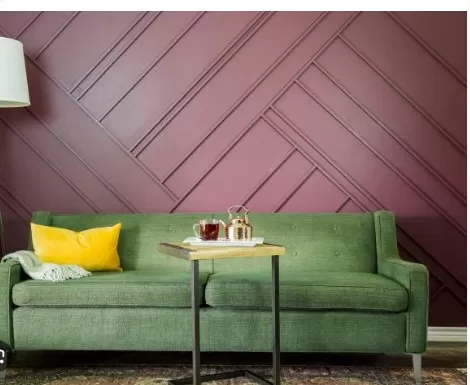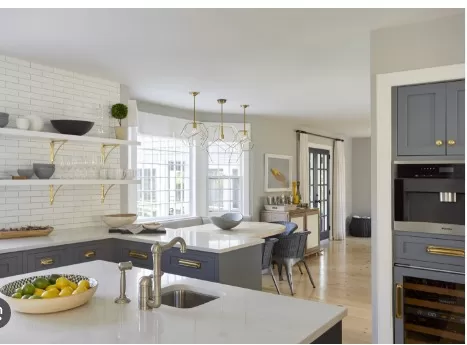Corrugated Metal Decor: 5 Simple and Stylish Ideas. Corrugated metal, once mainly used for shed roofing, has found its way into fascinating and unexpected spaces, both indoors and outdoors. This versatile material is now being creatively incorporated into various areas of the home and yard, adding a unique and industrial aesthetic.
From interior accent walls and ceilings to kitchen backsplashes and furniture pieces, corrugated metal brings a touch of rugged charm and modern appeal. Outdoors, it can be used for fences, privacy screens, garden planters, and even as siding for sheds or outdoor structures. Embracing corrugated metal opens up a world of design possibilities and allows you to bring a distinctive and stylish element to your living spaces.
Transform Your Space with an Industrial Accent Wall

Ready to bring a touch of industrial charm to your home? With just a few simple steps, you can create a stunning accent wall that will instantly elevate your space.
Here’s how to do it:.
Measure and Cut the Metal Sheet: Start by measuring the surface area where you want to install the accent wall.
Once you have the measurements, cut the metal sheet to the appropriate size. If you’re not confident in your cutting skills, you can have it professionally cut for you.
Secure Wood Strips to the Wall: Next, prepare the wall by attaching wood strips horizontally to create a support frame for the metal sheet.
Use a level to ensure that the strips are straight and evenly spaced. Secure them to the wall using screws or nails, making sure they are firmly in place.
Mount the Metal Sheet: Once the wood strips are in place, it’s time to mount the metal sheet onto the support frame.
Carefully position the sheet against the wall, ensuring it aligns perfectly with the wood strips. Use screws or nails to attach the metal sheet to the strips, making sure it is securely fastened.
Finishing Touches: To complete the industrial look, consider adding some finishing touches.
You can lightly sand the edges of the metal sheet to give it a distressed look, or apply a clear protective coat to preserve its appearance. Additionally, you can enhance the overall aesthetic by placing decorative items, such as vintage signs or industrial-style lighting, near the accent wall.
For a more detailed and visual guide, you can visit Western States Metal Roofing, where they provide step-by-step tutorials on creating accent walls with metal sheets.
Get creative and have fun with this project, and enjoy the unique and eye-catching focal point that your industrial accent wall will bring to your space!.
.
DIY Project: Create a Stylish Headboard with Corrugated Metal
If you’re looking to add a unique and industrial touch to your bedroom, creating a headboard with corrugated metal is a fantastic option.
It’s a great compromise if you don’t want to cover an entire wall with metal. Here’s how you can make your own corrugated metal headboard:.
Materials Needed:.
Corrugated metal sheet (pre-cut to your desired dimensions)
Cutting tools (such as tin snips or a metal cutting saw)
Design template (to replicate the desired shape)
Screws or nails
Wall anchors (if necessary)
Instructions:.
Choose the Design: Find or create a design template for your headboard.
You can either replicate the one pictured or come up with your own unique design. Make sure the dimensions of the template match the size of your corrugated metal sheet.
Prepare the Corrugated Metal: If you haven’t already, have the corrugated metal sheet cut to your desired dimensions.
This can be done at a local metal fabrication shop or by using appropriate cutting tools if you have the skills and tools to do it yourself.
Cut the Metal According to the Template: Place the design template on the metal sheet and trace the outline using a marker.
Use the cutting tools to carefully cut along the traced lines. Take your time to ensure precise cuts and smooth edges.
Attach the Headboard to the Wall: Position the corrugated metal headboard against the wall in your desired location.
Depending on the weight and size of the headboard, use screws or nails to secure it to the wall. If needed, use wall anchors to provide extra stability and support.
Finishing Touches: Once the headboard is securely attached, step back and admire your handiwork.
You can leave the metal in its natural state for an industrial look or consider applying a clear coat to protect the metal and add a subtle sheen. Additionally, you can enhance the overall aesthetic by incorporating other elements, such as string lights or hanging plants, around the headboard.
Remember to take Safety Precautions while working with metal, such as wearing protective gloves and goggles.
By following these steps, you’ll have a stylish and eye-catching corrugated metal headboard that adds a unique touch to your bedroom decor. Enjoy your new focal point!.
Embrace Rustic Charm: Incorporate Corrugated Metal in Your Kitchen

If you’re a fan of rustic aesthetics, consider incorporating salvaged corrugated metal into your kitchen design.
This versatile material can be used as a backsplash or as a surround for your kitchen island, adding a unique and affordable touch to your space. Here’s how you can go metal in the kitchen:.
Salvage Corrugated Metal: Look for salvaged or reclaimed corrugated metal sheets to give your kitchen an authentic rustic look.
You can often find these at salvage yards, architectural salvage stores, or online marketplaces. Make sure to measure the area you plan to cover to determine how much metal you’ll need.
Backsplash Installation: To use corrugated metal as a backsplash, start by cleaning and prepping the wall surface.
Cut the metal sheets to the appropriate size using tin snips or a metal cutting saw. Apply construction adhesive to the back of the metal sheets and press them firmly against the wall.
Secure the sheets in place using nails or screws. Be sure to wear gloves and eye protection during this process.
Island Surround: If you prefer to use corrugated metal as a surround for your kitchen island, measure the dimensions of the island and cut the metal sheets accordingly.
Attach the metal sheets to the sides of the island using screws or nails, ensuring they are securely fastened. For added stability, you can also use construction adhesive.
Finishing Touches: Once the metal is installed, step back and admire the rustic charm it brings to your kitchen.
Consider leaving the metal in its natural state for an authentic, weathered look. Alternatively, you can apply a clear protective coat to maintain its appearance and make it easier to clean.
Pair the corrugated metal with complementary elements like reclaimed wood, industrial lighting fixtures, or vintage-inspired accessories to enhance the rustic vibe.
By incorporating salvaged corrugated metal into your kitchen design, you can achieve an affordable and distinctive aesthetic upgrade.
Embrace the rustic charm and enjoy the unique character that corrugated metal brings to your kitchen space.
Create Your Own Outdoor Shower Oasis with Corrugated Metal
Transform your outdoor space into a refreshing oasis by building a functional and stylish outdoor shower using corrugated metal.
This weekend DIY project requires basic building skills and just a few materials. Here’s how you can get started:.
Materials Needed:.
Corrugated aluminum sheeting
Lumber (such as pressure-treated wood)
Outdoor shower kit (available at your local home improvement store)
Screws
Waterproof sealant.
Tools (including a saw, drill, level, and measuring tape).
Instructions:.
Plan and Prepare: Choose the location for your outdoor shower, keeping in mind factors like privacy and accessibility to water sources.
Measure and mark the area to determine the size of the shower enclosure.
Build the Frame: Use pressure-treated lumber to construct the frame for your outdoor shower.
Cut the lumber to the desired dimensions for the walls, floor, and roof of the enclosure. Assemble the frame using screws and ensure it is sturdy and level.
Install the Corrugated Metal Sheeting: Measure the dimensions of the walls and roof of the frame.
Cut the corrugated aluminum sheeting to fit each section. Attach the metal sheets to the frame using screws, making sure they are securely fastened.
Consider overlapping the sheets slightly for better water resistance.
Install the Outdoor Shower Kit: Follow the manufacturer’s instructions to install the outdoor shower kit.
This typically involves connecting the plumbing fixtures, such as the showerhead and valves, to a water source. Make sure to use waterproof sealant around the plumbing connections to prevent leaks.
Finishing Touches: Once the shower is installed, take some time to add finishing touches.
Apply a waterproof sealant or paint to protect the exposed wood and metal from the elements. Consider adding hooks or shelves inside the shower enclosure for convenience.
Enjoy Your Outdoor Shower: Your DIY outdoor shower is now ready to use! Step into your own private oasis and enjoy the refreshing experience of showering outdoors.
Remember to check local building codes and regulations before starting your project, as they may vary in different areas.
Take safety precautions when using tools and working with plumbing connections. With a bit of time and effort, you can create a functional and visually appealing outdoor shower using corrugated metal, adding a touch of style to your outdoor living space.
Create a Charming Patchwork Fence with Corrugated Metal

Don’t let smaller scraps of corrugated metal or discarded tin ceiling tiles go to waste! Instead, turn them into a unique and charming DIY fence that adds a touch of country charm to your landscape.
This low-cost project allows you to create a patchwork grid of mismatched squares, resulting in a distinctive and eye-catching fence. Here’s how you can assemble your own patchwork fence:.
Materials Needed:.
Smaller scraps of corrugated metal or tin ceiling tiles.
Lumber (pressure-treated wood is recommended).
Screws.
Saw.
Drill.
Level.
Measuring tape.
Safety gloves and goggles.
Instructions:.
Plan and Measure: Determine the desired length and height of your fence.
Measure and mark the positions for the fence posts, ensuring they are evenly spaced. Consider using pressure-treated wood for the fence posts to enhance durability and longevity.
Install the Fence Posts: Dig holes for the fence posts, ensuring they are deep enough to provide stability.
Place the fence posts in the holes and use a level to ensure they are plumb. Fill the holes with gravel or concrete to secure the posts in place.
Allow time for the concrete to set if using this method.
Cut the Corrugated Metal or Tin Tiles: Using a saw, cut the smaller scraps of corrugated metal or tin ceiling tiles into squares of various sizes.
Aim for a patchwork effect, combining different textures, colors, and patterns to create an eclectic look.
Attach the Metal Squares: Starting at one end of the fence, attach the metal squares to the fence posts using screws.
Overlap the squares slightly to create an interesting patchwork grid pattern. Use a drill to pre-drill holes in the metal and wood to prevent splitting.
Continue the Installation: Move along the fence, attaching more metal squares until the entire fence is covered.
Take care to vary the placement and arrangement of the squares for a truly patchwork appearance. Trim any excess metal if needed.
Finishing Touches: Once the metal squares are securely attached, step back and admire your handmade country charm fence.
Consider applying a clear coat or rust-resistant paint to protect the metal and enhance its appearance. Add any additional decorative elements like hanging plants or outdoor lighting to complement the fence.
Note: It’s important to wear safety gloves and goggles when handling and cutting the corrugated metal or tin tiles.
With a little creativity and some DIY spirit, you can transform smaller scraps of corrugated metal or tin ceiling tiles into a one-of-a-kind patchwork fence.
Enjoy the distinctive and handmade country charm that this unique fence brings to your landscape.
*The information is for reference only.